Dune: The 'terraformed' Oregon dunes that inspired Frank Herbert's sci-fi epic
 Nathaniel Scharping
Nathaniel ScharpingWhen Frank Herbert saw how ecologists had manipulated the sands of Oregon's coast, it would influence his sci-fi novel Dune – but in the present day, that human intervention has triggered unexpected consequences.
Just south of the town of Florence, Oregon, a strip of sand dunes stretches between the Pacific Ocean and a thick forest of pines and spruces. These shifting hills are constantly reforming – ridges last mere days, entire mountains of sand melt away and reform each year. It's said that you cannot step in the same river twice. Here, you cannot walk the same dune twice, either.
From the right perspective, Oregon's dunes can feel endless as you walk among them, as if you have wandered into the Sahara, or perhaps even another planet entirely. There is sand here, lots of sand. More than enough to bury a town.
The prospect of dune invasion was what brought a young journalist named Frank Herbert to Florence in the 1950s. Sand dunes near Florence were threatening to cover houses, roadways, railroad tracks, and farms, making human inhabitation impossible. He observed how ecologists and engineers with the US Soil Conservation Service (SCS), among other agencies, were stopping the sand with an ambitious plan to "terraform" the landscape.
The trip would leave a lasting impression on Herbert – and he would later draw on the experience when writing one of the most influential science-fiction stories of all time. In his epic novel Dune, the characters' ambition to control the sands of the desert planet Arrakis is a prominent theme. (The second part of Denis Villeneuve's Hollywood adaptation arrived in cinemas on 1 March.)
If Herbert, who died in 1986, were to visit the Oregon coast today, he might well reflect on all that has happened since. As the BBC discovered on a recent visit, the landscape has changed significantly since the author was there seven decades ago. Along with this terraforming transformation have come unanticipated outcomes, though the solutions are far from clear. Is it life imitating science fiction? Or perhaps science fiction come to life?
 Warner Bros
Warner BrosFrank Herbert was born in Tacoma, Washington, about six hours north of Florence. As a young man he swam in the Puget Sound, and rambled in the lush forests of the Pacific Northwest, an experience that instilled a deep admiration, and concern, for the natural world. He worked for a time as a newspaper editor in San Francisco, and began writing science fiction stories in the early 1950s, spinning fables from his eclectic interests in religion, sociology, psychology and more. Herbert was drawn to esoteric niches of science, and around 1953 he'd become fascinated by dunes, which were like rivers of sand, he said in a later interview. When he learned of the terraforming project in Oregon, he travelled to the coast to see it for himself.
When Herbert arrived in Florence, he flew over the scalloped dunes in a small plane, and talked with the scientists on the ground. They told him how they were planting grasses along the dunes near the ocean to stabilise the sand and build up a living bulwark. The SCS had been nurturing beds of beach grass around the town, hoping to eventually eliminate the sand entirely and make the coast a lush haven of forests and fields of crops.
 Getty Images
Getty ImagesHerbert was taken with the ecologists' bravado, and impressed by their success at transforming the landscape. He sent notes to his agent for an article he titled "They stopped the moving sands", which was never published. But later, when he was imagining the desert planet of Arrakis in Dune, he returned to his experience. In his story, initially serialised in the magazine Analog, the nomadic Fremen people plan a generations-long project to transform their barren world into a paradise using tactics that mimic almost exactly those employed by the SCS on the Oregon Coast.
In an appendix to Dune, describing the Arrakis project, Herbert wrote: "Downwind sides of old dunes presented the first plantation areas. The Fremen aimed first for a cycle of poverty grass with peatlike hair cilia to intertwine, mat and fix the dunes by depriving the wind of its big weapon: movable grains."
The "poverty grass" Herbert describes is a dead ringer for Ammophila arenaria, or European beachgrass, which scientists brought to the Oregon coast sometime around the turn of the 20th Century. They were inspired by earlier efforts in France, where engineers had successfully tamed moving sand dunes near Gascony by planting forests along their edges. European beachgrass, with its thin stems, or tillers, and densely woven root system, proved to be even more adept at capturing blowing sand and anchoring a dune.
 Nathaniel Scharping
Nathaniel Scharping"What the Fremen are doing in terms of their own terraforming project is really coming directly from the dunes," says Veronika Kratz, a literary scholar at Canada's Queen's University who has written about Dune. "In a sense, it is the Oregon dunes transposed to an entire planet."
In Dune, the science is the terraforming Herbert saw on the Oregon coast. The fiction, perhaps, is that such a project could ever be done so well.
Remaking a landscape
Today, a string of small to medium-size towns dot the Oregon coast, filled with beach cottages, artisanal bakeries, and art galleries, and it is a popular vacation spot for families and retirees. It was all made possible by the earnest terraforming schemes imported by European settlers more than a century ago, says Sally Hacker, a coastal ecologist at Oregon State University who studies the Oregon dunes.
"I think this is really the story of a lot of these coastal towns that are in front of dunes," she says. "They weren't able to really settle there until they were able to stabilise it."
You may also like:
Stabilisation efforts around Florence began early in the 20th Century, first with willow trees to act as a windbreak, and progressing to beachgrass. Eventually, they hoped, the beachgrass would be replaced by other plants that would establish a virtuous cycle of soil creation and plant growth, turning the barren landscape green. Between 1910 and 1916, the US Forest Service oversaw the planting of beachgrass, shrubs, and trees near the town, and by the 1950s when Herbert visited the dunes they were already well on their way to being stabilised.
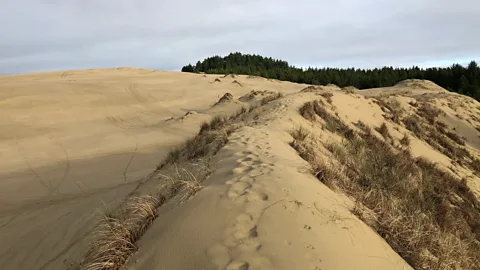 L Nathaniel Scharping
L Nathaniel ScharpingVisitors today can see, fully realised, what Herbert had to imagine. In many places, an archipelago of grassy hillocks 75-100cm-tall (30-39in) dot the dunes, halting their movements. The European beachgrass they planted, sometimes called marram grass, has stems and roots that can fix entire ridgelines of sand in place. Unlike other species of beachgrass it grows vertically, sending out new rhizomes upwards, which means it can keep pace with dunes as they get taller.
Over time, the planting has anchored a tall sand embankment called a foredune, which parallels the shore. It captures sand transported by waves and wind, starving the landscape inland of building material, and creating a flat, sunken deflation plain with marshy areas that can extend more than a kilometer behind the foredune.
This landscape is not native, and would not be recognisable to the indigenous inhabitants of the Oregon coast 200 years ago. But it makes the place livable. Florence, and other towns along the coast are safe, more or less, hidden behind foredunes that still a restless ocean of sand.
 Nathaniel Scharping
Nathaniel ScharpingHerbert was impressed by the capacity of plants to remake a landscape. It was an insight that, for him, underlined the power of understanding the natural world, a realisation that drives the plot of Dune. "The thing the ecologically illiterate don't realise about an ecosystem, is that it's a system. A system!" says the planetary ecologist Liet Kynes, who begins teaching the Fremen to terraform Arrakis, in the book. "That's why the highest function of ecology is the understanding of consequences."
Those words would have rung true to the ecologists of the 20th Century, living under the long shadow of the American Dust Bowl. During the 1930s, poor agricultural practices turned the US Great Plains into a barren dystopia of dry, blowing soil. As a result, ecologists of the 20th Century saw blowing soil and sand as nothing less than an existential threat to humanity, to be stopped at all costs.
"What you see happening on the Oregon coast and what you see happening with the SCS as it continues… is still an attempt to avoid the Dust Bowl," Kratz says.
In Oregon, the ecologists likely saw themselves as applying their hard-won wisdom for the benefit of humanity. Human folly had once set the soils loose; now they were being tamed. The terraforming project has enabled generations of people to live, work, and play along this picturesque stretch of Pacific coast.
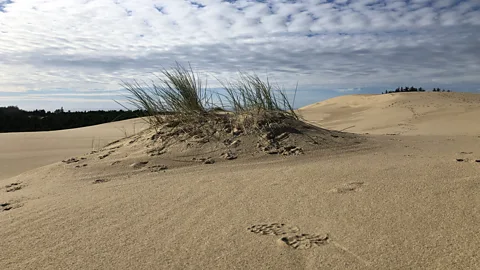 Nathaniel Scharping
Nathaniel ScharpingThat privilege has not come without consequences, however.
The European beachgrass that holds the sands fast is steadily spreading beyond the areas it was planted in. Invasive species like gorse and Scotch broom introduced by European settlers have come with it, crowding out native species. Hardy coastal inhabitants like pink sand verbena with its delicate lilac flowers and red fescue are threatened on the Oregon coast, and animals like the snowy plover and Siuslaw hairy-necked tiger beetle, one of the fastest insects on the world, are also in peril.
More than that, the landscape itself is disappearing. "We're losing about five feet [1.5m] of open sand every year," says Dina Pavlis, a longtime Florence resident, author of Secrets of the Oregon Dunes, and member of the Oregon Dunes Restoration Collaborative.
"I live on a street that backs up to dunes where I hike. And when we moved there, it was all open sand as you would walk," she says. Today, "the trees are almost closing it off where you can't even see the sand".
The open sand, once seen as a threat, is actually a threatened resource worth saving, Pavlis and others argue. She and other members of the ODRC have laid out a three-pronged plan to save the dunes, which includes restoring natural processes by knocking down foredunes, protecting remaining natural dune environments, and conducting targeted interventions to save endangered species.
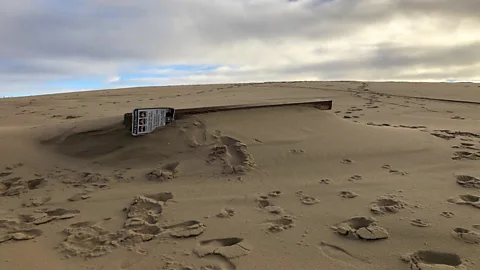 Nathaniel Scharping
Nathaniel ScharpingThe ODRC includes people who at other times might be at odds with one another, like environmental groups and off-road vehicle riders. They find a shared purpose in saving the open dunes, Pavlis says.
"We all agree on the value," she says. "We know if nothing gets done, it's going to be gone."
The group has leveled foredunes in several places along the Oregon coast, restoring natural dune-building processes critical to maintaining the native landscape. They bring work parties to the dunes to remove beachgrass and invasive plants like scotch broom by hand, and use bulldozers and prescribed burns in other places.
The restoration practices work, though they are rarely permanent. European beachgrass returns to the open sand if it isn't kept at bay by human intervention. More existential issues pressure the fight to save the dunes as well.
Living with the sands
On the north edge of Florence, outside of a Fred Meyer grocery store, you can see harbingers in the parking lot. Grains of sand tumble across the pavement and collect against curbs, ambassadors from the massive dune that lurks just behind the store. The dune top is tracked with the imprint of bulldozer treads, evidence of the constant battle to keep it from encroaching on the store and the nearby roadway.
The grocery store's plight is indicative of the complexity of attempting to live with the dunes. The foredunes that keep sand from moving are destabilising the landscape and imperiling wildlife. But without them, the town might soon become unlivable.
"When I talk about the story, I also remind people in the audience… you all got in your car and drove here today," Pavlis says. "You didn't have to get out and shovel sand out of the way."
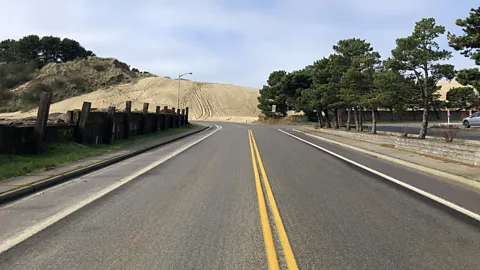 Nathaniel Scharping
Nathaniel ScharpingThe residents of the Oregon coast have discovered further nuances as they struggle with the question of what to do about the sand. Foredunes sequester large amounts of carbon by providing a haven for beach grasses. They also provide a better, and more sightly, means of protecting against rising seas than the jumbled piles of rocks called riprap used elsewhere. Some wealthy homeowners have removed foredunes from their properties to better their views, Hacker says, only to be faced with the reality of incoming sand.
One particular irony arose in 2020, when the Humboldt marten, a species of cute, carnivorous mammal related to weasels and otters was listed as endangered. The species had been pushed out its usual shrubby habitat as a result of human activities, and lives now in the deflation plains behind the foredunes. Grading the foredunes to restore the native ecosystem would erase the marten's habitat, something forbidden under the Endangered Species Act. That listing halted some of the ODRC's restoration work — consequences stacking atop consequences.
Even knowing what restoration means is difficult today, Hacker says, because historical descriptions are rare. "There's very little information, very little natural history of what things were like 150 years ago in our region."
Instead, she and her colleagues today are trying to help coastal residents make better decisions about how to balance the different services dunes can offer. Things like protection from tsunamis, opportunities for recreation, protection from sand, and carbon storage are often referred to as ecosystem services, which the dunes, in both their natural and less-natural iterations offer.
"How do we partition up the coast in smart ways that that basically give us the most bang for our buck in terms of ecosystem services?" she says.
It is a more pragmatic vision of living in harmony with the natural world than that promoted by some environmentalists, who seek to restore the world to the way it was millennia ago. For better or worse, humans are also part of the natural world.
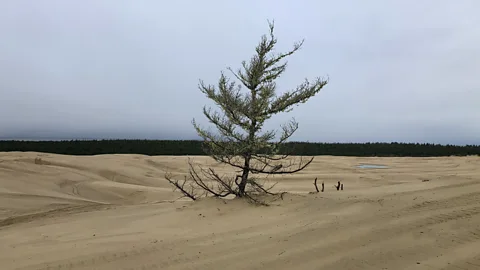 Nathaniel Scharping
Nathaniel ScharpingHerbert may well have agreed. In a 1981 interview, he said "I look upon our involvement with the environment – and, by the way, all of man's intrusions into the environment are totally natural phenomena – as a continual learning process."
When Herbert wrote Dune in the late 1950s and early 1960s, the field of ecology was in its infancy, and not well known among the public. Rachel Carson's foundational environmental book Silent Spring, long credited with galvanising the environmental movement in the United States, wouldn't be published until 1962, just a year before Dune began serialisation.
Herbert's views of ecology likely differed from our own today, Kratz says. To him, it was "a way of understanding the natural world and also a way for people to control the natural world in a way that, today, we would problematise."
Seen from Herbert's perspective, humanity's century-plus history of involvement in the Oregon dunes is simply an iterative process gradually moving us toward a better relationship with the sands. Whether that's possible is an open question.
"Harmony to me isn't necessarily a native dune that is restored to what it was 200 years ago," Hacker says. Should we live in the dunes? Perhaps not. "But we are. The reality is that we are living in that habitat," she says.
Hacker envisions a middle path for people who choose to live on the coast. With better knowledge of coastal ecology, we could find ways to use dunes to protect people, while also potentially stepping back from coastlines in places where the conflicts are too stark.
 Warner Bros
Warner BrosFor its part, the world of Dune offers little guidance for the residents of Oregon. In ChildrenofDune, the emperor Leto II Atreides, the grandson of Dune's protagonist Paul Atreides, has a vision that reveals the origins of the massive sandworms that swim through the planet's deserts. The beasts were brought to the planet eons ago by humans as small creatures called sandtrout. Arrakis at that time was filled with water and life, much like Earth is today. The sandtrout, let loose in a new habitat, encapsulated all of the water, turning Arrakis into a desert, evolving into the sandworms as they did so.
Arrakis was made into a desert by humans, who then attempted to unmake it. So it is in Oregon, though in reverse — we turned what appeared to be a desert into a grassland, only to change our minds.
It is a message with deep significance today, as ambitious projects to grow forests, coral reefs, kelps beds, and more seek to restore balance to our environment. Will we see the same process play out in these places? Already there are hints of conflict: one 2024 opinion paper in Science assessing plans to conduct large-scale tree planting in Africa notes that about half the land earmarked for trees consists of native savanna, and that putting forests there would disrupt the native ecosystem. Elsewhere, some scientists have proposed transplanting hardier coral species from Indonesia to the Caribbean to replace dying reefs there, even as others say the idea poses risks to other species.
Herbert might smile at our predicament, or perhaps grimace. As he wrote in Dune, "ecology is the understanding of consequences".
*Nathaniel Scharping is a science writer based in Tacoma, Washington. Find more of his work at nathanielscharping.com.
--
If you liked this story, sign up for The Essential List newsletter – a handpicked selection of features, videos and can't-miss news delivered to your inbox every Friday.
